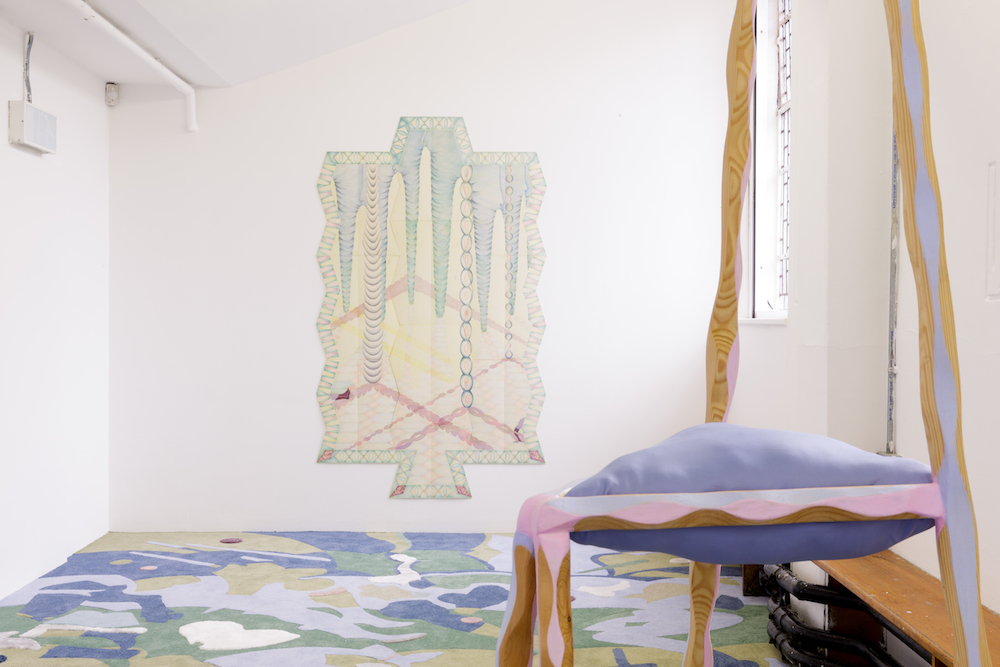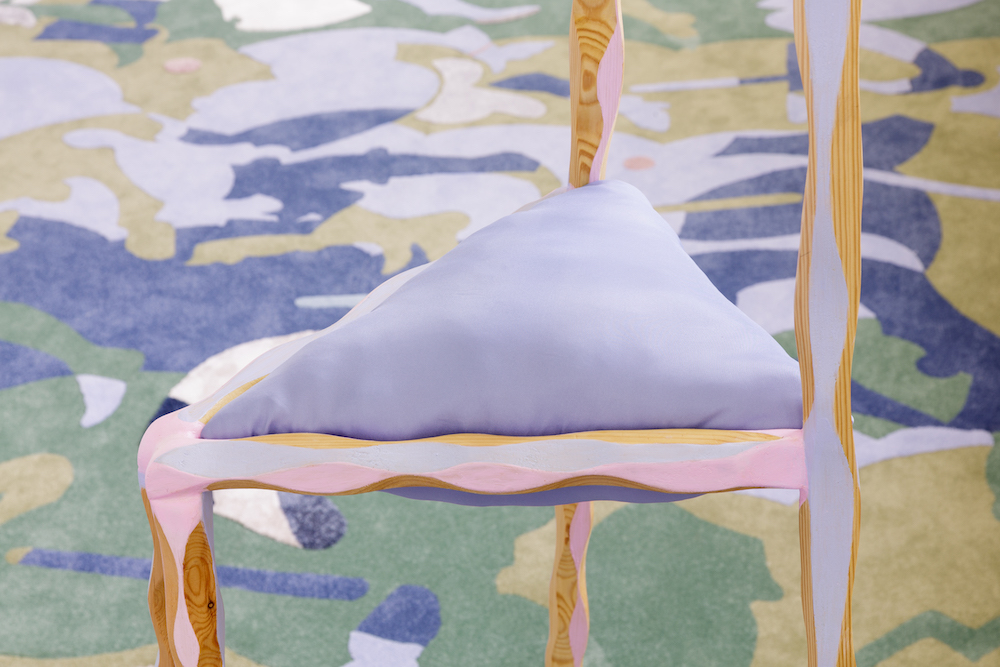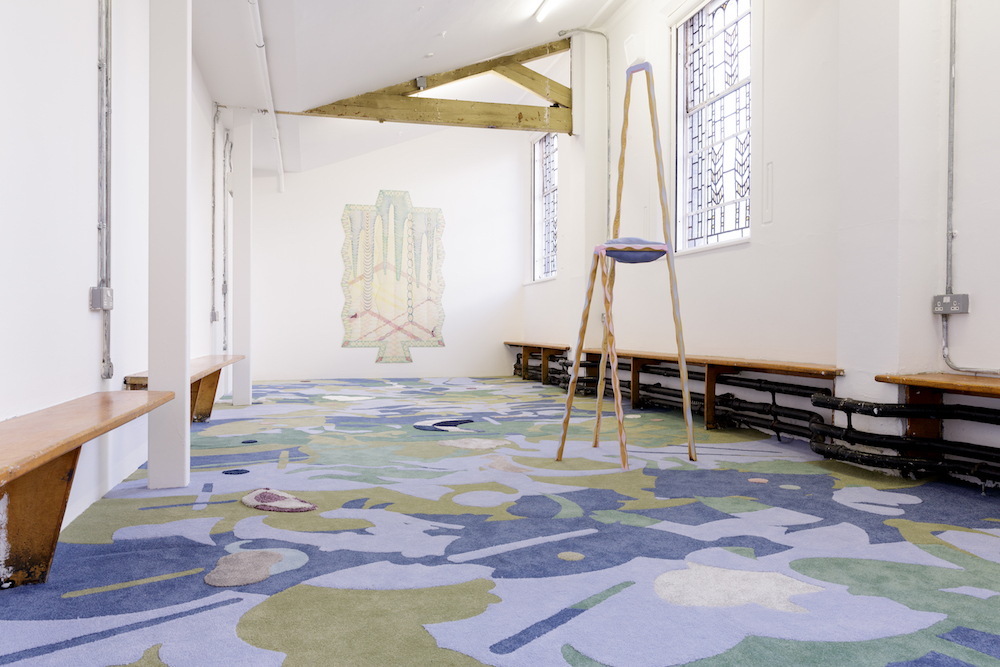
In her most recent exhibition at the Zabludowicz Collection’s Invites space, Bonafini took over the building’s side chapel with muted tones and undulating shapes. A dysfunctionally tall wooden chair stood elegantly over an intricate (and oh-so-soft!) handmade carpet, whilst the large pencil drawing Proposition for a Non-Religious Chapel II hung, altar-like, on the end wall. With her command of colour and texture, Bonafini manages to introduce a serenity into a space that allows viewers to contemplate, questioning their relationships to others and the spaces they inhabit.
In your recent installation Dovetail’s Nest, you carpeted the whole of the Zabludowicz Collection’s side chapel with a piece inspired by the marble floor of the Siena Duomo. Can you tell me a little more about this work and the process of making it?
The beauty of the Siena’s floors lies in seeing skillfully cut marble shapes come together to compose narrative scenes of great complexity. Where the details have worn away, the image left behind dances between figuration and abstraction. I wanted to maintain this aspect of a horizontal picture that is overwhelming, that you can walk over and around, offering many more physical perspectives.
The process was physically challenging but exhilarating. After a series of technical drawings, the carpets were cut in undulating patterns and reassembled. Working on the reverse side, figures of fallen soldiers, horses, animal and human limbs, batons and shields were cut out from one end of the carpet and swapped with an identical cutout on the other side. Each figure therefore appears twice, always in a different configuration, mimicking the mirror-aspect of a battle. The swapping of figures allows shapes to emerge, while creating a dynamic whereby one side is effectively fighting itself.

Your sculptural work often references furniture but is sometimes functional and sometimes not. Do you feel it’s important for your work to be activated by viewers?
It is important for my work to have an intimate physical connection with viewers, but sometimes it’s enough for it to exist in their minds. The great thing about furniture is that it inhabits our most intimate space: the home. I can use carpet to evoke a mentality of comfort and domesticity, or use the structure of a coffee table to bring to mind social connections. But I want the way these objects are encountered to shift fluidly from one show to the next, depending on what suits the context.
“I will always admire the determination of religions to create spaces of immense beauty to elevate the soul and inspire awe.”
Dovetail’s Nest was not the first time you have made reference to places of worship in your work. In your show at FieldWorks gallery you exhibited a pencil work named Proposition for a Non-Religious Chapel I. What interests you about these spaces?
I will always admire the determination of religions to create spaces of immense beauty to elevate the soul and inspire awe. They understand that beauty is a material version of goodness, and can remind us of virtues like love and kindness. All of my thoughts and problems with the secular world were perfectly worded in Alain de Botton’s Religion for Atheists. Even if we don’t believe in a supernatural God, there is no reason why secular society should not have spaces of beauty purely dedicated to thought and reflection, and I don’t mean galleries or museums. In my drawings on non-religious chapels, I created imaginary spaces where light, shadows, patterns, totemic sculptures and height are the main focus. Although there are hints of human limbs here and there, these are decentering spaces, where the ego takes a back seat.

Your work displays a beautiful command of colour. Can you trace your choices of palette back to any particular influences?
My palette is something I create instinctively, but which is the subconscious result of my environment. I return home to Italy often in the year, where the quality of light is simply unique. When working there on a residency I think my work absorbed some of the softness of the Tuscan autumnal light, as well as the wall frescoes in the residence we lived in. Each room was frescoed differently; the villa was spooky and magical. Similarly, I want my palette to be the seductive entry point to a more psychological and complex subject matter at the core of the work.

Performance and video are also a part of your practice. How do you feel this ties in with your sculptural work?
Performances are a way for me to collaborate and to get out of my own head. I enjoy seeing people excited about a shared project; it counterbalances the solitude of working alone in the studio, surrounded by all my doubts and insecurities. I’ve spent years making collaborative performances using my body, which explored the relationship between two people, and the tensions of individuality and collectivity that lies at the heart of my work that is puzzle-like. It also impacts the choices I make that reference domestic furniture–the relationship dynamics in the home or the way people come together in public spaces to exchange life stories.
In my ongoing banquet series, sculpture, performance and social gathering collide in one ephemeral day. They’re moments of magic for me, and their memory ends up feeding new works for months, or even years.






